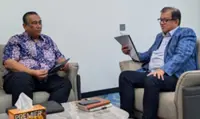A display of Bornean photos, information and masks at the gallery. — Photos: FLOREY D. MIKIL/The Star
Did you know that certain antiques featured in the Hollywood movie Crazy Rich Asians came from a Kuala Lumpur-based art gallery?
In fact, that’s not even its first encounter with Hollywood, or specifically, its owner’s first encounter.
Already a subscriber? Log in
Save 30% OFF The Star Digital Access
Cancel anytime. Ad-free. Unlimited access with perks.





